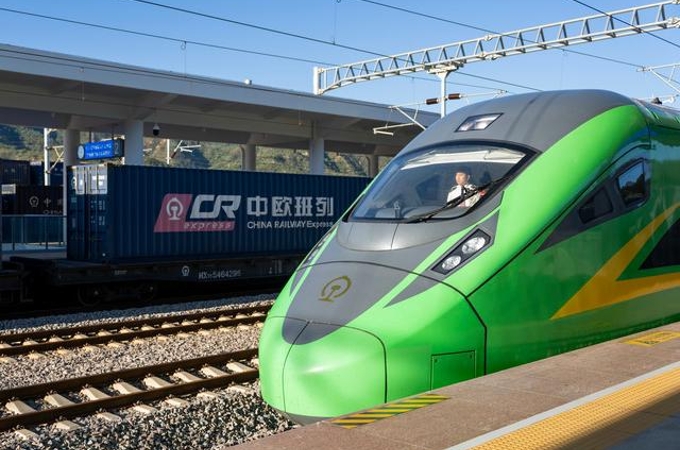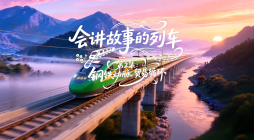Across China: Northwest China markets wine with classy Chinese culture
Source: Xinhua | 2023-06-06 | Editor:Lexi
For many alcohol connoisseurs from China, the terms "wine" (putaojiu in Chinese) and "winery" (jiuzhuang) often evoke European associations of romance and nobility, a stereotype winemakers have long endorsed to attract the country's middle-and-upper-class consumers.
But in one wine-producing area in northwest China's Ningxia Hui Autonomous Region, wineries are using the traditional Chinese culture to render a different taste to the stories behind their brands.
Wine bottles with ancient Chinese paintings, racks named after the Chinese 24 solar terms, and traditional Chinese-style architecture ... such are the common features of many wineries lying in the eastern foothill of Helan Mountain.
"The first time I visited the wineries in Ningxia, I was surprised to see so many traditional Chinese cultural elements in their buildings. It's really good indeed," said Maria Teresa Romero Ponce, a Chilean winemaker working in the Moon & Stone Winery in Ningxia.
Ningxia boasts a unique terroir in making top-class wine, with its prolonged sunshine and a cool, dry climate contributing to grape planting. Since the production of its first bottle of wine in 1984, the land-locked region has become a rising star on the world's wine map, with local wine winning several top international awards.
While wine brewing had been introduced into China as early as the Han Dynasty (202 BC - 220 AD), the modern Chinese wine industry has long been modeled on its European peers and used the wine's European pedigree as a marketing strategy.
"Ningxia has been learning from Europe especially France and used to bid itself as 'China's Bordeaux'," said Zhang Junxiang, professor with the Ningxia University.
"But now we are trying to develop our own characteristics, and local winemakers declare they come from China's Helan Mountain," said the long-time observer of China's wine industry.
The Chateau Lansai has been a pioneer in making local wine appear more Chinese.
After a wine-tasting tour around Europe in 2013, the winery's owners demolished their European-style winery buildings, which were still under construction, and opted for a Chinese design.
"The chateaus we visited were in similar European styles. Then we began to think, why can't we construct a Chinese style winery and brew wine with Chinese characteristics?" said Yu Xiaojia, one of the winery owners.
Upon entering the Chateau Lansai, visitors are greeted by a Chinese-style spirit screen, two old trees, and a stone statue of the grape goddess similar to the Flying Apsaras of the Mogao Grottoes.
Chinese symbols such as zodiac animals are commonplace in the winery, which has two Shanxi-style buildings and a delicate garden complete with a pond, streams, a pavilion, a bridge and sight-seeing terraces.
"We often receive international friends, and they are quite interested in the cultural elements of our winery. Some even wore traditional Chinese outfits during their second visit," said Yu.
Guests are also invited to taste the wine while sitting cross-legged on the heatable brick bed, just like dining with an ordinary rural family in north China.
"We try to break the stereotype that wine is limited to formal occasions. It is a drink that brings mirth and can blend into various scenarios of the Chinese lifestyle," she said.
Christelle Chene, the international affairs director of Xi'ge Winery, observes that the traditional Chinese culture has played an important role in Ningxia's wine promotion both domestically and internationally.
With a bottle of wine in her hand, Chene told customers the brand label is inspired by a painting of peach and turtledove drawn by a Chinese emperor in Song Dynasty, and that the wine's unique herbal flavor is from the special native variety of grape named Shelongzhu.
"Many customers are curious about the Chinese elements of our brand stories," she said. "Traditional Chinese culture is attractive. It makes our products more impressive and charming."
You May Like
-
China makes constant progress in RMB internationalization
China's Renminbi (RMB) has constantly expanded its international circle of friends as China sees better economic development and a higher level of opening up, p...
InKunming 2023-06-03 -
China kicks off first crewed mission for application, develo...
China's Shenzhou-16 manned spaceship, atop a Long March-2F carrier rocket, blasted off from the Jiuquan Satellite Launch Center in northwest China at 9:31 a.m. ...
InKunming 2023-06-03 -
Explainer: Delving into America's debt crisis
The U.S. Congress's passage of the debt ceiling bill late Thursday, just days before a looming default deadline, might have come as a respite for global inves...
InKunming 2023-06-03 -
World's biggest trade deal takes effect for all members, boo...
The full RCEP implementation marks a new stage for the world's largest trade bloc.
InKunming 2023-06-03 -
Nation's first offshore carbon capture project put into use
The operation of China's first offshore carbon capture and storage demonstration project will further facilitate China's carbon peak and neutrality goals, as oi...
InKunming 2023-06-02 -
Cooperation key to speed up tech breakthroughs
Greater international cooperation is needed to explore technological frontiers such as computer-brain interface technologies and artificial intelligence, which ...
InKunming 2023-06-02 -
Efforts sought to curb minors' online addiction
Legal experts have called for cyberspace departments to tighten supervision over e-commerce platforms and ban them from selling or renting online video game acc...
InKunming 2023-06-02 -
Tibetan kids tour Beijing for Children's Day
Forty children from a welfare home in Yushu Tibetan autonomous prefecture, Qinghai province, were invited to Beijing to tour the city and participate in educati...
InKunming 2023-06-01 -
Authorities work to shield minors online
Procuratorial organs have focused on the crux of problems in cyberspace to protect the legitimate rights and interests of minors online, said officials on Wedne...
InKunming 2023-06-01 -
400-year-old family tree manuscript discovered in north Chin...
A family tree manuscript dating back to the Ming Dynasty (1368-1644) has been discovered in north China's Hebei Province. It is believed to be significant to th...
InKunming 2023-06-01







